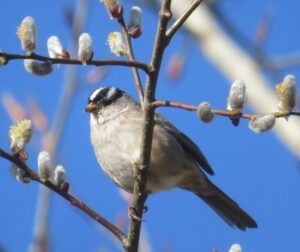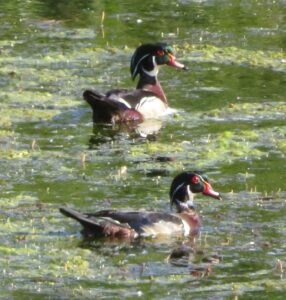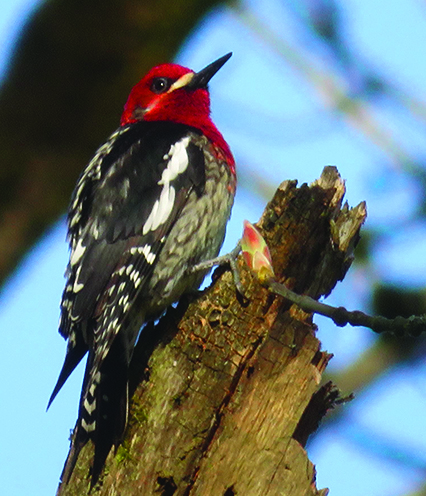When Richard Niemeyer bought his wife, Debbie, a pair of binoculars in 2011 he never could have imagined the impact the gift would have on both of their lives.
“It wasn’t a particularly expensive pair,” Debbie said of the gift. “But one of the first things I saw was an osprey.”
Still one of the couple’s favorite birds because of the spectacular way it dives from the sky to catch fish, that first osprey opened their eyes to an entirely new hobby – birding.
“I like the continual learning,” Debbie, who went on to take online courses in bird identification, said. “And you can just about do it anywhere. It just depends on the habitat you want.”
Relatively new to Marion County – they relocated from California in 2019 to be near family – the Niemeyers wasted no time in getting to know their new home and its birds, despite the pandemic that arrived only a few months after they did.
“During the pandemic it was lifesaving for me,” Debbie confirmed. “We’ve been fortunate since coming here to get out and bird more. It’s been a lot of fun.”

Richard agreed, “We’ve only been here two years but we’ve been all over the place.”
Thus far their favorite areas have included Silver Falls, Milo McIver and Willamette Mission State Parks, Ankeny Wildlife Refuge and the Silverton Reservoir.
“It’s just anywhere where you can be quiet and view different habitats,” Richard said of the diversity of areas in which birds are found.
“You can just about do it anywhere,” Debbie agreed. Noting that, even in her own neighborhood there are many species to be found.
“One of my favorite things – if we’re not going anywhere – is to sit outside and listen and look,” she said.
Each habitat yields an entirely different array of birds. For example, after the fires swept through the Santiam Canyon, that habitat changed somewhat, welcoming the possibility of new species including the olive-sided flycatcher.

“It looks for burned stumps,” Debbie said of this small gray bird whose call sounds like a toast to “three beers”.
“It forces you to go out,” Richard continued, detailing the many unusual treks he and Debbie have taken in the hopes of seeing unusual birds, like the long-eared owl – an elusive species that generally roosts in dense foliage.
“You saw lines of birders [looking for them] because it’s a life lister,” Richard said of the affect the sighting – and subsequent listing on the birding app, eBird – had on the number of birders who ventured to the area in hopes of getting a peek.
“It’s amazing whoever saw them,” Debbie pointed out. “Because these owls are pretty stealthy.”
But even stealthy birds can often be heard, which is where another birding app, Merlin Bird ID, comes in handy.
“There are 400 birds based on sound,” Richard said of the site’s ever-growing, citizen science-based database.
“It’s only about 50 percent right but it gives you a starting point.”
It also gives beginning birders another way to connect with the birds around them.
“I didn’t realize how much was oral instead of visual,” Debbie said of her own introduction into the world of bird vocalizations.
“Calls are mainly for contact and alarms and songs for attracting a mate, keeping a mate and territory [disputes],” she said, listing some of the facts she’s learned in the past ten years.
“A lot of times there are multiple songs and multiple calls and that’s been really challenging.”
Also challenging is the silence and stillness required to see some of the shyer species.
“They tell you to sit for five to ten minutes and the birds will come out,” Richard laughed. “But it’s not natural to be quiet like that.”
It can also be tricky if there are others around.
“Spring and summer there are more visitors,” Debbie said, describing why birding in popular tourist locations can be challenging. But it’s a tradeoff because, as she said, “In winter there are less birds.”
There also tends to be more inclement weather, which can make viewing certain birds all but impossible.
“If you get really high winds, it’s hard to hear them,” Debbie explained. “And in the rain, they hunker down.”
But even on a day with few sightings, the couple still has fun getting out of the house.
“You get to be outdoors,” Richard said of the reason he began joining his wife in the hobby. “You go places you wouldn’t otherwise go – places you wouldn’t think about.”
And maybe, if you’re lucky, you’ll see a bird you didn’t think you’d see.
Birding Recommendations
Equipment
• Binoculars – an 8×42 Nikon is recommended
• Sturdy hiking boots
• Camera with a zoom lens
References
• www.salemaudubon.org
• www.ebird.org
• Merlin Bird ID app
• Kaufman Field Guide to Birds of North America by Kenn Kaufman
Great Backyard Bird Count
Feb. 18 -21, 2022 – 25th Annual
New participants welcome
www.birdcount.org

